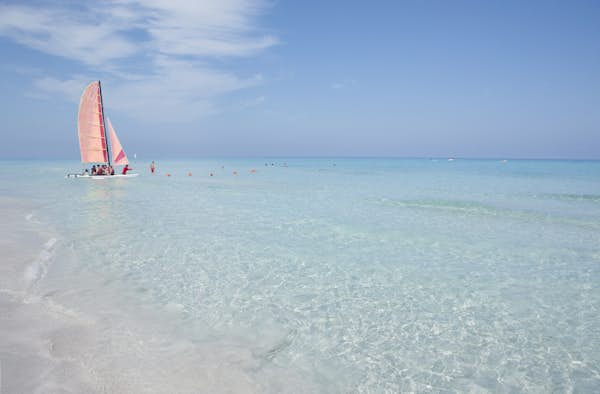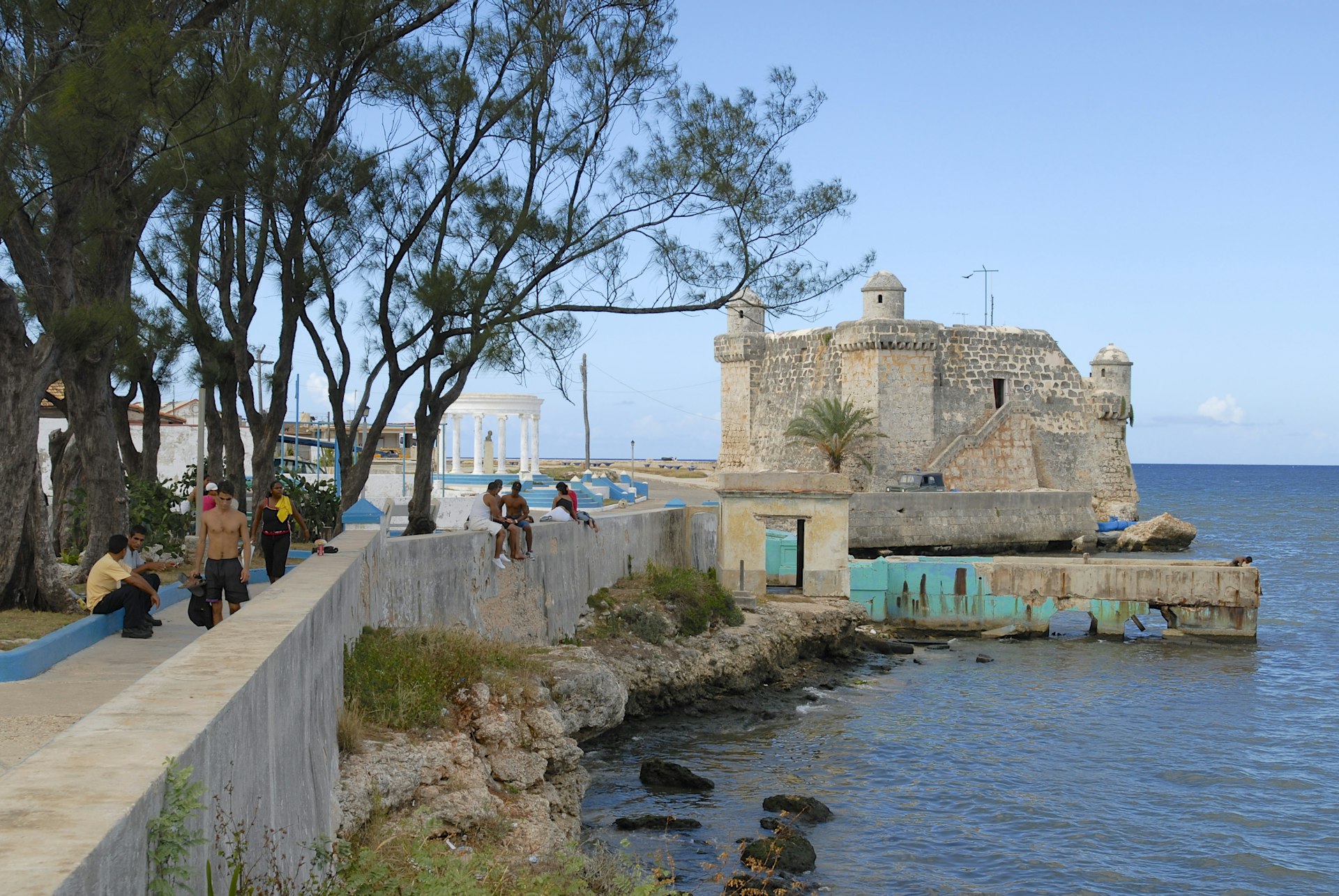
While Havana, with its grandiose architecture and vibrant culture, continues to be the number one place to visit for travelers to Cuba, taking a break from the city buzz will recharge your batteries and give you a broader scope of Cuba’s authentic experiences.
Let the sea breeze pamper your senses in Playas del Este or indulge your ecological side in Las Terrazas and Soroa. With so many great options less than an hour away from the Capitolio, Havana is the perfect base for a day trip filled with adventure.
Methods of payment for transportation vary depending on whether it’s private or state-run. For the Havana Bus Tour (to Playas del Este) and Viazul buses (to Viñales, Matanzas and Varadero), you’ll have to pay by credit card and will be charged in MLC, Cuba’s convertible currency, which has the same value as US dollars. Private taxis usually prefer foreign cash (euros are best). Agree on the currency and price before you start your journey.
Make the most out of every adventure with help from our weekly newsletter delivered to your inbox.  If you have time, consider lingering for more than a day in the gorgeous Viñales Valley © mrtom-uk / Getty Images
If you have time, consider lingering for more than a day in the gorgeous Viñales Valley © mrtom-uk / Getty Images
1. Explore the beautiful landscapes of Viñales
Travel time: 2 hours 45 minutes
Viñales Valley, peppered with rare pin-cushion hills, is spectacular enough to warrant longer than a day trip if you have the time. The town is quaint in that ceramic-roof, cane-rocker-on-the-porch kind of way, and the hospitality of Cuban guajiros (countryfolk) is unsurpassed. Accept any invite to go horseback riding or hiking amid the oddly bulbous limestone mogotes (hills). Viñales becomes a rock climbing mecca from December through April. The A-frame structures covered in shaggy fronds you will see are drying houses for the world’s finest cigar tobacco, grown throughout this part of Pinar del Río province.
Los Jazmines is the perfect lookout point for some world-prize-worthy panoramic photos over Viñales Valley, but choose Balcón del Valle restaurant if you also fancy having lunch while overlooking the mogotes. For a friendly ambiance and freshly made cocktails, don’t miss Tres Jotas on Salvador Cisneros St, Viñales’ main road.
How to get to Viñales from Havana: Viñales is connected with Havana by daily Viazul buses. You can also book day trips at Havana’s hotels, most of which include lunch and added excursions, for around MLC$70 round trip. For more flexibility, rent a car or hire a taxi with a driver for the day.
2. Unwind at Playas del Este
Travel time: 30 minutes
Not far from the hustle and grit of Havana’s city center is the palm-fringed coast known as Playas del Este (eastern beaches). Half a dozen beaches are out this way, but Santa María del Mar – with appreciable shade and the softest, cleanest sand – is the best. Head to the beach town of Guanabo to hang with locals. The stretch near Boca Ciega is a traditional LGBTIQ+ hangout. Most Cubans will not go near the beach in the “cold” winter months between January and April, but during the peak summer season, these beaches get incredibly crowded.
Guanabo has an assortment of paladares (Cuban private diners) ranging from Italian-inspired pizzerias to kid-friendly chicken restaurants.
How to get to Playas del Este from Havana: Hop on the T3 Habana Bus Tour, which runs from Centro Habana to Playas del Este (via Parque Histórico Militar Morro-Cabaña). The main stop is in Parque Central opposite the Hotel Inglaterra. All-day tickets for T3 cost MLC$10 and services run from 9am to 7pm. A regular private cab costs the equivalent of around US$25 one way.
 Enjoy the peaceful natural pursuits on offer around Las Terrazas and Soroa © Holger Leue / Getty Images
Enjoy the peaceful natural pursuits on offer around Las Terrazas and Soroa © Holger Leue / Getty Images
3. Embrace nature at Las Terrazas and Soroa
Travel time: 1 hour
A drive into the heart of the undulating and verdant Sierra del Rosario range, Cuba’s first Unesco Biosphere Reserve, is a sure tonic for fatigue and worry. Las Terrazas, 1 hour west of Havana, is a former artist colony turned ecotourism experiment with open studios, canopy, hiking, birdwatching and swimming in river cascades.
Nearby Soroa is famed for its Orquideario, an orchid garden and research station with more than 700 species that bloom between December and March. Off-the-radar Lago El Palmar hosts a ranchón (rustic, opened-sided restaurant) offering drinks and snacks, plus an option for renting boats. Less than 2km (1 mile) away is Cafetal Buenavista, a well-preserved remnant of Cuba’s oldest coffee plantation.
How to get to Las Terrazas and Soroa from Havana: Book a day tour to Las Terrazas and Soroa at a Cubatur desk in any hotel lobby or take a colectivo (shared taxi mainly used by tourists) at the Viazul station and hop off at Rancho Curujey, near Las Terrazas. Make sure to confirm your stop with the driver.
 Make an early start from Havana and you could be on the beach in Varadero by mid-morning © diego_cervo / Getty Images
Make an early start from Havana and you could be on the beach in Varadero by mid-morning © diego_cervo / Getty Images
4. Swim in the crystal-clear waters of Varadero
Travel time: 2 hours 20 minutes
Cuba’s finest beach destination, a 20km-long peninsula with powdery sand, bathtub-temperature sea and all-inclusive resorts, Varadero has all the amenities required to enjoy a fun-filled day trip. Take an early ride 140km (87 miles) east of Havana center and you’ll be sitting under a palm leaf umbrella before 10am. Take a dip in one of the Caribbean’s most pristine beaches or sip cocktails in the shade before heading out for a late lunch at any of Varadero’s notable restaurants. With impeccable service and seafood, Varadero 60 is highly recommended. For an after-lunch spirit, opt for the mahogany-wood Bar Mirador atop Mansión Xanadú. The view over the sunbathed peninsula is simply unparalleled.
How to get to Varadero from Havana: Book an air-conditioned Viazul bus at Terminal de Ómnibus (MLC$9; 3–4 hours). When Viazul buses are in high demand, colectivos taxis are also an option and are quicker. You can book one directly at any hotel desk, at your casa particular or just by hanging around at the bus station. A regular taxi from Havana costs the equivalent of around US$100 to US$150 one way.
 Soak up Cuban local life in Cojímar © Dmitry_Chulov / Getty Images
Soak up Cuban local life in Cojímar © Dmitry_Chulov / Getty Images
5. Explore Cojímar, Hemingway’s favorite fishing village
Travel time: 20 minutes
Just east of Havana’s old quarter is the charming fishing village of Cojímar, famous for hosting Ernest Hemingway’s maritime adventures back in the 1940s and 1950s. Tourist buses usually stop at Restaurante La Terraza for a daiquiri on the terrace, but more hearty meals and fantastic mojitos are offered at Ajiaco Café. This little town is a slow-paced community, where it’s possible to meet locals in a 100% Cuban environment. Walk around the malecón, a smaller version of Havana’s iconic promenade, for a glimpse of the natural allure that enchanted Papa all those years ago.
For the best pictures of the seaside town, head to the Torreón de Cojímar, a wrecked Spanish fort from the 17th century that was the first to be taken by the British when Havana was attacked in 1762.
How to get to Cojímar from Havana: Yellow cabs from Parque Central or any other part of Old Havana cost the equivalent of around US$10 to Cojímar. Old American classic cars may be more expensive, but the scenic ride is definitely worth it. Agree with the driver on a one-way fare if you’ll spend more than a couple of hours in Cojímar, but ask for a round-trip offer if you only want a glimpse of the landmarks.
 Head to Matanzas for music filled streets and one of the biggest art festivals in Cuba © Lena Wurm / Shutterstock
Head to Matanzas for music filled streets and one of the biggest art festivals in Cuba © Lena Wurm / Shutterstock
6. Check out music and culture in revitalized Matanzas
Travel time: 1 hour 45 minutes
Ignored for decades in favor of Varadero, Matanzas, a once-prosperous cultural hub 100km (62 miles) east of Havana, is making a comeback. A government-sponsored renovation campaign initiated in 2018 to celebrate the city’s 325th anniversary sparked the renaissance. The staging of the Biennial – Cuba’s biggest art festival – in the city the following year raised its profile further.
The improvements are most marked in the rejuvenated art and architecture of Calle Narváez. Once part of a grubby warehouse district beside the San Juan River, this attractive waterside promenade has become the city’s beating heart dotted with free-to-enter galleries, public sculpture and a lively ensemble of bars and restaurants, including the cafe-cum-art-collective, Artys.
Elsewhere, look out for matinee performances at the restored Teatro Sauto, and check out the pots and potions at the longstanding pharmaceutical museum. If you arrive on a Friday afternoon, you might get lucky with some live street rumba (Afro-Cuban music and dance) in the historic confines of Plaza de la Vigía.
How to get to Matanzas from Havana: The city is accessible on daily Viazul buses (MLC$7; two hours). A taxi will get you there in around one hour and 45 minutes, but is more expensive. Bank on the equivalent of US$80 and up.



